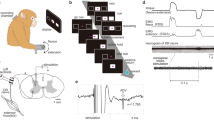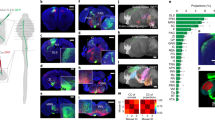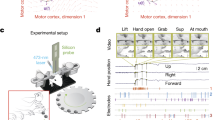Abstract
During normal voluntary movements, re-afferent sensory input continuously converges on the spinal circuits that are activated by descending motor commands. This time-varying input must either be synergistically combined with the motor commands or be appropriately suppressed to minimize interference. The earliest suppression could be produced by presynaptic inhibition, which effectively reduces synaptic transmission at the initial synapse. Here we report evidence from awake, behaving monkeys that presynaptic inhibition decreases the ability of afferent impulses to affect postsynaptic neurons in a behaviorally dependent manner. Evidence indicates that cutaneous afferent input to spinal cord interneurons is inhibited presynaptically during active wrist movement, and this inhibition is effectively produced by descending commands. Our results further suggest that this presynaptic inhibition has appropriate functional consequences for movement generation and may underlie increases in perceptual thresholds during active movement.
This is a preview of subscription content, access via your institution
Access options
Subscribe to this journal
Receive 12 print issues and online access
$209.00 per year
only $17.42 per issue
Buy this article
- Purchase on Springer Link
- Instant access to full article PDF
Prices may be subject to local taxes which are calculated during checkout







Similar content being viewed by others
References
Baldissera, F., Hultborn, H. & Illert, M. Integration in spinal neuronal systems. in Handbook of Physiology (ed. Brooks, V. B.) 509–595 (American Physiological Society, Bethesda, Maryland, 1981).
Willis, W.D. & Coggeshall, R.E. Sensory Mechanisms of the Spinal Cord (Plenum Press, New York, 1991).
Rushton D.N., Rothwell, J.C. & Craggs, M.D. Gating of somatosensory evoked potentials during different kinds of movement in man. Brain 104, 465–491 (1981).
Shimazu, H. et al. Pre-movement gating of short-latency somatosensory evoked potentials. Neuroreport 10, 2457–2460 (1999).
Angel, R.W. & Malenka, R.C. Velocity-dependent suppression of cutaneous sensitivity during movement. Exp. Neurol. 77, 266–274 (1982).
Milne, R.J., Aniss, A.M., Kay, N.E. & Gandevia, S.C. Reduction in perceived intensity of cutaneous stimuli during movement: a quantitative study. Exp. Brain Res. 70, 569–576 (1988).
Duysens, J., Tax, A.A, Trippel, M. & Dietz, V. Increased amplitude of cutaneous reflexes during human running as compared to standing. Brain Res. 613, 230–238 (1993).
Capaday, C. & Stein, R.B. Amplitude modulation of the soleus H-reflex in the human during walking and standing. J. Neurosci. 6, 1308–1313 (1986).
Rudomin, P. & Schmidt, R.F. Presynaptic inhibition in the vertebrate spinal cord revisited. Exp. Brain Res. 129, 1–37 (1999).
Pecci-Saavedra, J., Wilson, P.D. & Doty, R.W. Presynaptic inhibition in primate lateral geniculate nucleus. Nature 210, 740–742 (1966).
Ennis, M. et al. Dopamine D2 receptor-mediated presynaptic inhibition of olfactory nerve terminals. J. Neurophysiol. 86, 2986–2997 (2001)
Andersen, P., Eccles, J.C., Schmidt, R.F. & Yokota, T. Depolarization of presynaptic fibres in the cuneate nucleus. J. Neurophysiol. 27, 92–106 (1964).
Baldissera, F., Broggi, G. & Mancia, M. Primary afferent depolarization of trigeminal fibres induced by stimulation of brain stem and peripheral nerves. Experientia 23, 398–400 (1967).
Wall, P.D. Excitability changes in afferent fibre terminations and their relation to slow potential. J. Physiol. 142, 1–21 (1958).
Jankowska, E., Slawinska, U. & Hammar, I. Differential presynaptic inhibition of actions of group II afferents in di- and polysynaptic pathways to feline motoneurones. J. Physiol. 542, 287–299 (2002)
Miller, R.J. Presynaptic receptors. Annu. Rev. Pharmacol. Toxicol. 38, 201–227 (1998).
Eccles, J.C., Eccles, R.M. & Mangi, F. Central inhibitory action attributable to presynaptic depolarization produced by muscle afferent volleys. J. Physiol. 159, 47–166 (1961).
Gossard, J.P., Cabelguen, J.M. & Rossignol, S. Phase-dependent modulation of primary afferent depolarization in single cutaneous primary afferents evoked by peripheral stimulation during fictive locomotion in the cat. Brain Res. 537, 14–23 (1990).
Menard, A., Leblond, H. & Gossard, J.P. Sensory integration in presynaptic inhibitory pathways during fictive locomotion in the cat. J. Neurophysiol. 88, 163–171 (2002).
Duenas, S.H. & Rudomin, P. Excitability changes of ankle extensor group Ia and Ib fibers during fictive locomotion in the cat. Exp. Brain Res. 70,15–25 (1988).
Morrison, A.R., Pompeiano, O. Depolarization of central terminals of group Ia muscle afferent fibres during desynchronized sleep. Nature 210, 201–202 (1966).
Cairns, B.E., Fragoso, M.C. & Soja, P.J. Active-sleep-related suppression of feline trigeminal sensory neurons: evidence implicating presynaptic inhibition via a process of primary afferent depolarization. J. Neurophysiol. 75, 1152–1162 (1996).
Hultborn, H., Meunier, S., Pierrot-Deseilligny, E. & Shindo, M. Changes in presynaptic inhibition of Ia fibres at the onset of voluntary contraction in man. J. Physiol. 389, 757–772 (1987).
Nielsen, J. & Kagamihara, Y. The regulation of presynaptic inhibition during co-contraction of antagonistic muscles in man. J. Physiol. 464, 575–593 (1993).
Perlmutter, S.I., Maier, M.A. & Fetz, E.E. Activity of spinal interneurons and their effects on forearm muscles during voluntary wrist movements in the monkey. J. Neurophysiol. 80, 2475–2494 (1998).
Haugland, M. A flexible method for fabrication of nerve cuff electrodes. 18th Annual International Conference of the IEEE Engineering in Medicine and Biology Society, IFESS, Amsterdam (1996).
Hulliger, M., Nordh, E., Thelin, A.E. & Vallbo, A.B. The responses of afferent fibres from the glabrous skin of the hand during voluntary finger movements in man. J. Physiol. 291, 233–249 (1979).
Janig, W., Schmidt, R.F. & Zimmermann, M. Two specific feedback pathways to the central afferent terminals of phasic and tonic mechanoreceptors. Exp. Brain Res. 6, 116–129 (1968).
Frank, K. Basic mechanisms of synaptic transmission in the central nervous system. IEEE Trans. Med. Electr. 6, 85–88 (1959).
Eccles, J.C., Schmidt, R.F. & Willis, W.D. Depolarization of the central terminals of cutaneous afferent fibers. J. Neurophysiol. 26, 646–661 (1963).
Flament, D., Fortier, P.A. & Fetz, E.E. Response patterns and postspike effects of peripheral afferents in dorsal root ganglia of behaving monkeys. J. Neurophysiol. 67, 875–889 (1992).
Carpenter, D., Engberg, I. & Lundberg, A. Primary afferent depolarization evoked from sensorimotor cortex. Acta Physiologica Scandinavia 59, 126–142 (1963).
Fetz, E.E. Pyramidal tract effects on interneurons in the cat lumbar dorsal horn. J. Neurophysiol. 31, 69–80 (1968).
Fetz, E.E., Cheney, P.D., Mewes, K. & Palmer, S. Control of forelimb muscle activity by populations of corticomotoneuronal and rubromotoneuronal cells. Prog. Brain Res. 80, 437–449 (1989).
Fetz, E.E., Finocchio, D.V., Baker, M.A. & Soso, M.J. Sensory and motor responses of precentral cortex cells during comparable passive and active joint movements. J. Neurophysiol. 43, 1070–1089 (1980).
Kriz, N., Sykova, E., Ujec, E. & Vyklicky, L. Changes of extracellular potassium concentration induced by neuronal activity in the spinal cord of the cat. J. Physiol. 238, 1–15 (1974).
Jimenez, I., Rudomin, P. & Solodkin, M. Mechanisms involved in the depolarization of cutaneous afferents produced by segmental and descending inputs in the cat spinal cord. Exp. Brain Res. 69,195–207 (1987).
Brink, E., Jankowska, E. & Skoog, B. Convergence onto interneurons subserving primary afferent depolarization of group I afferents. J. Neurophysiol. 51, 432–449 (1984).
Eguibar, J.R., Quevedo, J., Jimenez, I. & Rudomin, P. Selective cortical control of information flow through different intraspinal collaterals of the same muscle afferent fiber. Brain Res. 643, 328–333 (1994).
Jenner, J.R. & Stephens, J.A. Cutaneous reflex responses and their central nervous pathways studied in man. J. Physiol. 333, 405–419 (1982).
Burke, D., Gracies, J.M., Mazevet, D., Meunier, S. & Pierrot-Deseilligny, E. Non-monosynaptic transmission of the cortical command for voluntary movement in man. J. Physiol. 480, 191–202 (1994)
Burke, R.E., Jankowska, E. & Bruggencate, G. A comparison of peripheral and rubrospinal synaptic input to slow and fast twitch motor units of triceps surae. J. Physiol. 207, 709–732 (1970).
Hongo, T., Kitazawa, S., Ohki, Y. & Xi, M. Functional identification of last-order interneurons of skin reflex pathways in the cat forelimb segments. Brain Res. 505, 167–170 (1989).
Garnett, R. & Stephens, J.A. The reflex responses of single motor units in human first dorsal interosseous muscle following cutaneous afferent stimulation. J. Physiol. 303, 351–364 (1980).
Rustioni, A., Hayes, N.L. & O'Neill, S. Dorsal column nuclei and ascending spinal afferents in macaques. Brain 102, 95–125 (1979).
Cliffer, K.D. & Willis, W.D. Distribution of the postsynaptic dorsal column projection in the cuneate nucleus of monkeys. J. Comp. Neurol. 345, 84–93 (1994).
Rustioni, A. Spinal neurons project to the dorsal column nuclei of rhesus monkeys. Science 196, 656–658 (1977).
Dick, S.H., French, A.S. & Rasmusson, D.D. Postsynaptic dorsal column and cuneate neurons in raccoon: comparison of response properties and cross-correlation analysis. Brain Res. 914, 134–148 (2001).
Moschovakis, A.K., Sholomenko, G.N. & Burke, R.E. Differential control of short latency cutaneous excitation in cat FDL motoneurons during fictive locomotion. Exp. Brain Res. 83, 489–501 (1991).
Egger, M.D., Freeman, N.C., Jacquin, M., Proshansky, E. & Semba, K. Dorsal horn cells in the cat responding to stimulation of the plantar cushion. Brain Res. 383, 68–82 (1986).
Acknowledgements
We thank J. Garlid, S. Gilbert, L. Shupe and S. Votaw for technical assistance. This work was supported by National Institutes of Health grants NS 12542, NS36781 and RR00166, and Human Frontiers Science Program grant LT0070/1999-B.
Author information
Authors and Affiliations
Corresponding author
Ethics declarations
Competing interests
The authors declare no competing financial interests.
Rights and permissions
About this article
Cite this article
Seki, K., Perlmutter, S. & Fetz, E. Sensory input to primate spinal cord is presynaptically inhibited during voluntary movement. Nat Neurosci 6, 1309–1316 (2003). https://doi.org/10.1038/nn1154
Received:
Accepted:
Published:
Issue Date:
DOI: https://doi.org/10.1038/nn1154
This article is cited by
-
Presynaptic gating of monkey proprioceptive signals for proper motor action
Nature Communications (2023)
-
Modulation of corticospinal excitability related to the forearm muscle during robot-assisted stepping in humans
Experimental Brain Research (2023)
-
Epidural electrical stimulation of the cervical dorsal roots restores voluntary upper limb control in paralyzed monkeys
Nature Neuroscience (2022)
-
Dependence and reduced motor function in heart failure: future directions for well-being
Heart Failure Reviews (2022)
-
Misencoding of ankle joint angle control system via cutaneous afferents reflex pathway in chronic ankle instability
Experimental Brain Research (2022)



